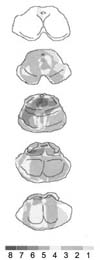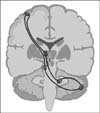Abstract
The brainstem is a compact, stalklike structure. It carries nearly all information between the brain and the remainder of body. It is a corridor to all major sensory, motor, cerebellar, cranial nerve pathways but it is not simply a conduit for information. It has numerous nuclei of the cranial nerves. Therefore, when a patient has a lesion in the brainstem, he or she will demonstrate a variety of symptoms regarding level of consciousness, motor control, muscle tone, posture, vegetative function and other essential function. Here, we will discuss about the non-motor symptoms caused by the brainstem lesions and the strategy for the rehabilitation.
Figures and Tables
Fig. 1
The maximum lesion overlap was in the center of pontine tegmentum for brainstem coma subjects with fatal hyperthermia.

References
1. Ciurleo R, Bramanti P, Calabrò RS. Pharmacotherapy for Disorders of Consciousness: Are 'Awakening'Drugs Really a Possibility? Drugs. 2013; 73:1849–1862.
2. Machado C, Estevez M, Redriguez R, Perez-Nellar J. Wakefulness and loss of awareness: Brain and brainstem interaction in the vegetative state. Neurology. 2010; 75:751–752.

4. Zuccoli G, Santa Cruz D, Bertolini M, Rovira A, Gallucci M, Carollo C, Pipitone N. MR imaging findings in 56 patients with Wernicke encephalopathy: nonalcoholics may differ from alcoholics. AJNR Am J Neuroradiol. 2009; 30:171–176.

5. Zuccoli G, Pipitone N. Neuroimaging findings in acute Wernicke's encephalopathy: review of the literature. AJR Am J Roentgenol. 2009; 192:501–508.

6. Thibaut A, Bruno M-A, Ledoux D, Demertzi A, Laureys S. tDCS in patients with disorders of consciousness Sham-controlled randomized double-blind study. Neurology. 2014; 82:1112–1118.

7. van Zandvoort M, de Haan E, van Gijn J, Kappelle LJ. Cognitive functioning in patients with a small infarct in the brainstem. J Int Neuropsychol Soc. 2003; 9:490–494.

8. Murakami T, Hama S, Yamashita H, Onoda K, Kobayashi M, Kanazawa J, Yamawaki S, Kurisu K. Neuroanatomic pathways associated with poststroke affective and apathetic depression. Am J Geriatr Psychiatry. 2013; 21:840–847.

10. Ishibashi A, Fujishima I. Lesion of the nucleus solitarius leads to impaired laryngeal sensation in bulbar palsy patients. J Stroke Cerebrovasc Dis. 2012; 21:174–180.

11. Prosperini L, Kouleridou A, Petsas N, Leonardi L, Tona F, Pantano P, Pozzilli C. The relationship between infratentorial lesions, balance deficit and accidental falls in multiple sclerosis. J Neurol Sci. 2011; 304:55–60.





 PDF
PDF ePub
ePub Citation
Citation Print
Print






 XML Download
XML Download